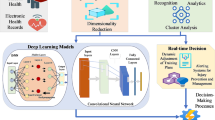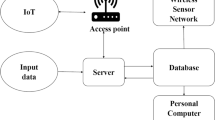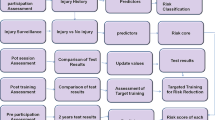Abstract
Smart healthcare monitoring systems are proliferating due to the Internet of Things (IoT)-enabled portable medical devices. The IoT and deep learning in the healthcare sector prevent diseases by evolving healthcare from face-to-face consultation to telemedicine. To protect athletes’ life from life-threatening severe conditions and injuries in training and competitions, real-time monitoring of physiological indicators is critical. In this research work, we present a deep learning-based IoT-enabled real-time health monitoring system. The proposed system uses wearable medical devices to measure vital signs and apply various deep learning algorithms to extract valuable information. For this purpose, we have taken Sanda athletes as our case study. The deep learning algorithms help physicians properly analyze these athletes’ conditions and offer the proper medications to them, even if the doctors are away. The performance of the proposed system is extensively evaluated using a cross-validation test by considering various statistical-based performance measurement metrics. The proposed system is considered an effective tool that diagnoses dreadful diseases among the athletes, such as brain tumors, heart disease, cancer, etc. The performance results of the proposed system are evaluated in terms of precision, recall, AUC, and F1, respectively.












Similar content being viewed by others
Explore related subjects
Discover the latest articles and news from researchers in related subjects, suggested using machine learning.References
Liu X, He P, Chen W, Gao J. (2019) Multi-task deep neural networks for natural language understanding. arXiv doi: https://doi.org/10.18653/v1/p19-1441
Sun J, Khan F, Li J, Alshehri MD, Alturki R, Wedyan M (2021) Mutual authentication scheme for ensuring a secure device-to-server communication in the internet of medical things. IEEE Internet Things J. https://doi.org/10.1109/JIOT.2021.3078702
Zhang Q, Yang LT, Chen Z, Li P (2017) An improved deep computation model based on canonical polyadic decomposition. IEEE Trans Syst Man Cybern Syst 48(10):1657–1666
Jan MA, Khan F, Khan R, Watters P, Alazab M, Rehman AU (2021) A lightweight mutual authentication approach for intelligent wearable devices in health-CPS. IEEE Trans Ind Inf 17(8):5829–5839
https://roboticsbiz.com/wearables-in-sports-smart-clothing-e-textile-technologies/ Accessed on May 22, 2021
Jan SR, Khan R, Khan F, Jan MA (2021) Marginal and average weight-enabled data aggregation mechanism for the resource-constrained networks. Comput Commun J 174:101–108
Jan MA, Khan F, Mastorakis S, Adil M, Akbar A, Stergiou N (2021) LightIoT: lightweight and secure communication for energy-efficient IoT in health informatics. IEEE Trans Green Commun Netw. https://doi.org/10.1109/TGCN.2021.3077318
Wu Y, Tan H, Qin L, Ran B, Jiang Z (2018) A hybrid deep learning-based traffic flow prediction method and its understanding. Transp Res Part C Emerg Technol 90:166–180. https://doi.org/10.1016/j.trc.2018.03.001
Xu Yu, Zhan D, Liu L, Lv H, Lingwei Xu, Junwei Du (2021) A privacy-preserving cross-domain healthcare wearables recommendation algorithm based on domain-dependent and domain-independent feature fusion. IEEE J Biomed Health Inform. https://doi.org/10.1109/JBHI.2021.3069629
Feng S, Zhou H, Dong H (2019) Using deep neural network with a small dataset to predict material defects. Mater Des 162:300–310. https://doi.org/10.1016/j.matdes.2018.11.060
Miao JH, Miao KH (2018) Cardiotocographic diagnosis of fetal health based on multiclass morphologic pattern predictions using deep learning classification. Int J Adv Comput Sci Appl 9:1–11. https://doi.org/10.14569/IJACSA.2018.090501
Ravi D, Wong C, Deligianni F, Berthelot M, Andreu-Perez J, Lo B et al (2017) Deep learning for health informatics. IEEE J Biomed Heal Inf 21:4–21. https://doi.org/10.1109/JBHI.2016.2636665
Smith L (1988) A tutorial on principal components analysis. Commun Stat - Theory Methods 17:3157–3175
Sindi H, Nour M, Rawa M, Öztürk Ş, Polat K (2021) A novel hybrid deep learning approach including combination of 1D power signals and 2D signal images for power quality disturbance classification. Expert Syst Appl 174:114785
Shahamat H, Abadeh MS (2020) Brain MRI analysis using a deep learning based evolutionary approach. Neural Netw 126:218–234
Fang C, Moriwaki Y, Li C, Shimizu K (2019) Prediction of antifungal peptides by deep learning with character embedding. IPSJ Trans Bioinf 12:21–29
Chou K-C (2010) Graphic rule for drug metabolism systems. Curr Drug Metab 11:369–378. https://doi.org/10.2174/138920010791514261
Wong TT, Yang NY (2017) Dependency analysis of accuracy estimates in k-fold cross-validation. IEEE Trans Knowl Data Eng 29:2417–2427. https://doi.org/10.1109/TKDE.2017.2740926
Liu G, Liu J, Cui X, Cai L (2012) Sequence-dependent prediction of recombination hotspots in Saccharomyces cerevisiae. J Theor Biol 293:49–54. https://doi.org/10.1016/j.jtbi.2011.10.004
Wong TT, Yeh PY (2020) Reliable accuracy estimates from k-fold cross-validation. IEEE Trans Knowl Data Eng 32:1586–1594. https://doi.org/10.1109/TKDE.2019.2912815
Miao Yu, Quan T, Qinglong Peng XY, Liu L (2021) A model-based collaborate filtering algorithm based on stacked autoencoder. Neural Comput Appl. https://doi.org/10.1007/s00521-021-05933-8
Zhou G-P, Chen D, Liao S, Huang R-B (2015) Recent progress in studying helix-helix interactions in proteins by incorporating the wenxiang diagram into the NMR spectroscopy. Curr Top Med Chem 16:581–590
Author information
Authors and Affiliations
Corresponding author
Ethics declarations
Conflict of interest
The authors declare no conflict of interest.
Additional information
Publisher's Note
Springer Nature remains neutral with regard to jurisdictional claims in published maps and institutional affiliations.
Rights and permissions
About this article
Cite this article
Wu, X., Liu, C., Wang, L. et al. Internet of things-enabled real-time health monitoring system using deep learning. Neural Comput & Applic 35, 14565–14576 (2023). https://doi.org/10.1007/s00521-021-06440-6
Received:
Accepted:
Published:
Issue Date:
DOI: https://doi.org/10.1007/s00521-021-06440-6




